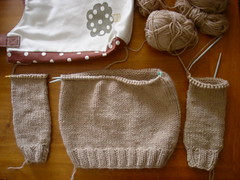



``Burgundy makes you think off silly things, Bordeaux makes you talk of them and Champagne makes you do them.´´
Jean-Anthelme Brillat-Savarin, French gastronome, (1755-1826)
When we were in Paris, my husband and I took a tour to the region of Champagne, an hour and a ½ northeast from Paris.
We visited two houses, Mumm (Reims) and Moët&Chandon (Epernay), a house that also produces the famous Dom Pérignon. The main grape used in the process of making champagne is the Pinot Meunier, known by its high acidity, which gives Champagne its distinct taste. This grape is harvested between September and early October.
The whole process of making champagne is really awesome and the craftsmanship is not shorter than impressive. Dom Pérignon is a prestige cuvée, meaning that it is made out of the best grapes of the highest-rated villages and are also made only in vintage years. The cellar master from the house will determine on whether or not, that year will be a vintage year or not. Another aspect that differ Cuvée from non-vintage is the time the vintage champagne is declared officially vintage. Three years out of each decade. It blew me away!
Throughout the tour, the guide explains each step of the process and at one point the guide elaborates about the riddling. The wine bottles are placed in A-frame racks, necks down.
The remueur, or riddler, goes through millions of bottles and manually, gives a slight and precise turn, 20, 30 45 and 60˚ degree. After six to eight weeks, the bottle is almost completely upside down, with the sediment (yeasts) resting in the neck of the bottle.
Then they start the dégorgement. They use a solution to freeze the top of the bottle. The bottle cap is removed and the sediment flies out. At this point, they add the liqueur d´expedition, a combination of sugar+wine and the champagne is rated into the following categories: Brut, (dry) Extra brut (less dry), sec (sweet) and demi-sec (sweetest).
Champagne is now recorked with real cork, instead of a bottle cap. Outstandingly every house only employs a hand-full of riddles. Mumm claims only 2 men are in charge of turning 6 thousand bottles a day. Revolving bottles is a very prestigious and honored job in the region.
Visiting the depths of the cold caves and learning where the champagne is born was a fantastic experience!
Na nossa visita à Paris, meu marido e eu fizemos uma excursão à região de Champagne, 1 ½ hora nordeste de Paris.
Visitamos duas casas, Mumm em Reims e Moët & Chandon em Epernay, esta casa também produz o famoso Dom Pérignon. As principais uvas utilizadas na produção do champanhe é a Pinot Meunier, conhecida pela sua elevada acidez e exatamente pelo qual o Champanhe se distingue dos outros vinhos. A colheita acontece nos meses de Setembro e final de Outubro.
A produção do champanhe é realmente impressionante e o trabalho envolvido não é nada menos que fascinante. Dom Pérignon é um champagne de prestígio, o que significa que ele é feito com as melhores uvas das mais selecionadas aldeias. O artesão mestre da adega determina se deve ou não, naquele ano, ser um ano vintage. Outro aspecto que difere Cuvée de não-vintage é o ano em que o champanhe vintage é declarado oficialmente vintage. Três anos à cada dez anos. É para pirar qualquer cabeça!
Durante todo o passeio, o guia explica o processo passo à passo, e num determinado ponto, o guia elabora sobre o remuage. As garrafas de vinho são colocados em armações de madeira, todas as garrafas com os gargalos direcionados para baixo.
O remueur, passa diariamente, por todos os milhões de garrafas, e manualmente, dá uma ligeira e precisa volta nas garrafas, 20, 30 45 e 60 graus ˚. Depois de seis à oito semanas, a garrafa está quase completamente de cabeça para baixo, com o sedimento descansando no gargalo da garrafa.
Então eles começam com o dégorgement do gargalo. Eles usam uma solução para congelar a parte superior do frasco. A tampa do frasco é removida e os sedimentos (fermentos) colados na tampa, voam para fora. Neste momento, o liqueur d´expedition é adicionado. Uma mistura de açúcar e vinho. Daí é que vai determinar-se a classificação do champanhe. Brut, (bem seco) Extra brut (Não tão seco), sec (doce), demi-sec (mais doce).
O Champanhe é agora tampado com cortiça, em vez de uma tampa de garrafa.
Nós perguntamos quantos trabalhadores especializados trabalham neste processo. Na Moët&Chandon, eles empregam alguns, não disseram quantos. A Mumm afirma que eles só têem 2 homens, e este é um trabalho altamente prestigiado e honrado na região.













No comments:
Post a Comment